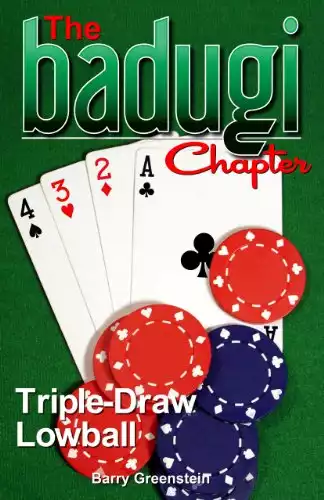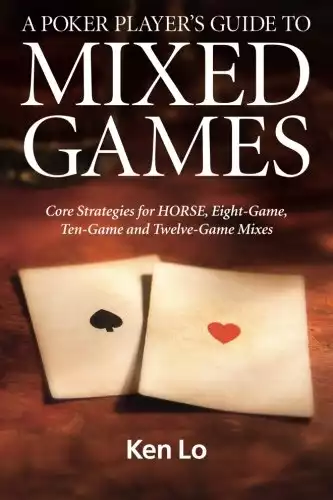Rules of the Game
Badugi is Korean for a black and white spotted dog and the goal of the game is to get a hand with all different “spots”. It is a triple draw lowball game where the players are each dealt four cards and the object of the game is to get the lowest hand possible with cards in different suits and of different ranks. If you obtain a hand with four unpaired unsuited cards you have a badugi e.g T♣ 9♥ 5♦ 2♠.
Aces are considered low, so the best possible hand is A234 of all different suits (e.g A♣ 2♥ 3♦ 4♠) and is called a four high badugi or just a four badugi. If you do not have a badugi then your hand is considered “incomplete”. There are varying degrees of incomplete. If you have three unpaired unsuited cards (e.g. J♠ 8♠ 5♥ 2♣ or 8♠ 5♥ 2♣ 2♦) you have what is known as a three card badugi or tri hand. The terminology is interchangeable and the hands shown are referred to as either a “three card eight” or an “eight high tri”.
Any badugi beats a tri hand, thus the worst possible badugi K♠ Q♦ J♥ T♣ beats A♣ 2♥ 3♦ 4♦. In game play the tri hand would discard the 4♦ and hope to get one of the following ten cards to pull ahead: 4♠, 5♠, 6♠, 7♠, 8♠, 9♠, T♠, J♠ Q♠, or K♠. The A♠, 2♠, and 3♠ are unhelpful because pairs do not improve the hand (of course the K♠ is dead in this particular example).
If the highest card is the same, then you look to the next cards in order to break any ties. For example, 9♥ 7♣ 6♦ 2♠ would beat both 9♠ 8♥ 2♦ A♣ and 9♠ 7♥ 6♦ 4♣. When you compare tri hands to each other you only look at the three lowest unpaired unsuited cards and break any ties in a similar fashion. For example, A♠ 5♣ 6♦ K♦ beats 3♠ 5♥ 6♣ J♠.
The game is played with blinds and usually is played fixed limit although it is sometimes also played pot limit.
Quick Facts
Before the first draw, the probability of being dealt certain type of hands is as follows:
| Badugi | 6.3% |
| Tri | 57.0% |
| 2 Card | 35.6% |
| 1 Card | 1.1% |
On the first draw, if you have a three card badugi there are ten cards that will make you a badugi among forty-eight unseen cards. Thus the odds are (10/48) or approximately 21% chance that you will make a badugi on the first draw.
Over the course of three draws you have around a 51% chance to obtain a badugi. This means that a typical tri hand is around 50/50 to draw out on a king high badugi by the end of the hand.
More than half of dealt pat badugis are kings or queens and the median is a good queen. However badugis obtained through drawing are typically stronger. As we noted before, ten different cards will give an A23 a badugi. 50% of them will make an 8 badugi or better.
It is possible to improve your hand without making a badugi. For example if you are holding A♠ 2♥ 6♦, in addition to your ten badugi outs you could also draw the 3♦, 4♦, or 5♦ which would give you a stronger tri hand. This is called reducing your incomplete.
A weak badugi is an underdog in a multiway pot because when two players hold tri hands and each of them draw three times at least one of them will make a badugi around 75% of the time. With three players the odds are around 88%.
With one draw remaining the best hand is a very large favorite. A tri hand that is chasing a badugi has at most ten outs or a 22% chance of making the best hand. An A23 is around an 81% favorite over both an A24 and 678.
Basic Strategy
The most profitable hands in Badugi are the rare dealt pat monsters (eight badugis or lower) and the premium three card badugis such as A23, 234, A34, A25 etc. These hands can be played strongly before the first draw in most situations.
Nine or ten high dealt badugis are profitable against a few players but in large multi-way pots even badugis as strong as these can be money losers. These hands suffer from reverse implied odds.
If no one has a badugi a premium tri is very strong and should be bet throughout. Do not give out free cards on the larger betting limit after the second draw. As was previously noted, the best hand is a big favorite with one draw to go so there is a lot of value in betting.
Since badugis are hard to make you should often make a play at the pot if you feel that you probably have a worse three card badugi than your opponent. The play is called “snowing” and is implemented by raising, staying pat, and betting the hand through. Of course it’s possible an aggressive player may try and make this play against you so you must sometimes just call down with strong tri hands. Some players do this often while others don’t even realize the play exists. As in all forms of poker it is very important to get a read on your opponents.
Starting Hand Standards
A reasonable set of opening requirements at most tables would be as follows:
Early position: Ten high or better badugis; Smooth 7 high tris or better
Hijack: Jack high or better badugis, Smooth 8 high tris or better
Cut-off: All badugis, 8 high tris or better, A2 and A3
Button: All badugis, 9 high tris or better, A2, A3, 23, A4
Further Learning
The Badugi Chapter by Barry Greenstein (Rating 7/10) – As the name suggests it is a short book but what is there is well written and helpful.
A Poker Player’s Guide to Mixed Games by Ken Lo (Rating 7/10) – This book is worthwhile for any mixed games player and there is a sizeable chapter on Badugi within the book. It’s definitely a good introduction to the game but it is a little bit too similar to a school textbook and at times very repetitive. He also has the tendency to branch off and focus on one particular topic within a particular game that isn’t very important. In the Badugi section a lot of time is spent discussing why you should remember your discards because it can possibly help you to make slightly better discard decisions in the future. In my opinion, I don’t think it’s worth going through this exercise as it may only happen occasionally that you may be able to use this information and when you can it would only add another out or two. It doesn’t seem like it is worth the effort as it is not fun to remember discards and can add to playing fatigue.


